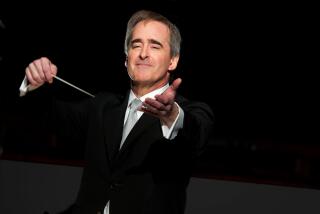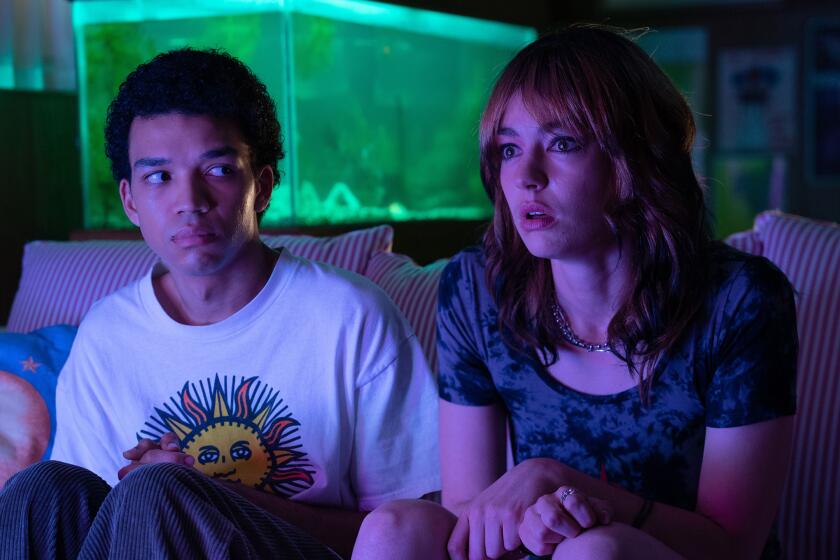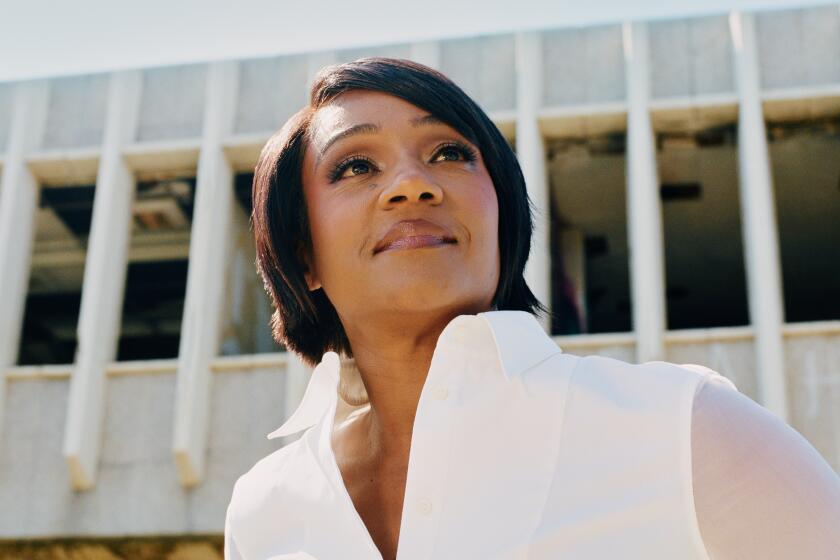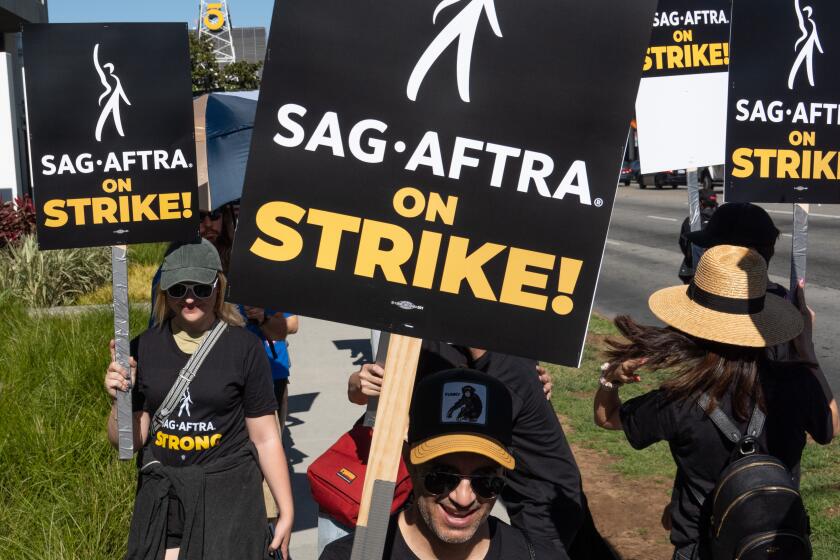In Disney Hall, Los Angeles Philharmonic has had its best decade yet

Conductor Gustavo Dudamel reflects on Walt Disney Concert Hall. Interview by David Ng.
For a few foolish moments in the feverish run-up to the opening of Walt Disney Concert Hall 10 years ago, cynical wags nicknamed the new venue Mouse House. Tomorrowland would have been more like it. The Los Angeles Philharmonic has enjoyed the most remarkable decade of its nearly 100-year history.
In Yasuhisa Toyota’s transparent acoustical design for Disney Hall, there is nowhere to hide. The surround-sound auditorium favors democracy over exclusive accommodations, since listeners sit in direct contact with the musicians and with one another. On every level, the musical experience is enhanced. An ensemble that can better hear itself and that has a closer connection to its audience will obviously grow. So, too, will the audience.
During the Disney decade, the L.A. Phil has become the envy of orchestras everywhere. It nabbed the hottest property in the conducting world when Gustavo Dudamel succeeded Esa-Pekka Salonen as music director in 2009.
PHOTOS: Performances in Disney Hall
It snagged John Adams as creative consultant. It entered into a commissioning frenzy, significantly renewing the repertory with dozens of new pieces, and many — by the likes of Salonen, Adams, Thomas Adès and Peter Lieberson — have become widely played and garnered major awards.
The combination of Disney and Dudamel has all but ensured full houses. An orchestra with surpluses, not deficits, has resulted in possibly the best compensated and most contented players in an often-contentious business. The L.A. Phil has even acquired, in Disney Hall, a modicum of hipness, to the degree that a symphony orchestra can be hip.
The venue all but demands innovation, and inside it the orchestra regularly stages opera and employs such groundbreaking artists as the hall’s architect Frank Gehry, video artist Bill Viola and director Peter Sellars. Los Angeles boasts the first big-league band to have produced a Minimalism festival (and it will host a second later this season).
Even so, it takes more than just a new hall for an orchestra to thrive in these days of technology-driven mass entertainment. A new hall will always initially boost ticket sales and orchestra morale, but it is not necessarily a long-term panacea.
Eight months before the Philadelphia Orchestra celebrated the 10th anniversary of its modern hall in the Kimmel Center, the ensemble became the first American orchestra of its size or stature to file for bankruptcy. In a worst-case scenario, the Minnesota Orchestra’s acrimonious labor dispute this past year has in part revolved around musicians furious at a management that eagerly raised millions for improvements in its concert hall lobby while insisting players’ salaries be drastically cut.
Perhaps the key to the L.A. Phil thriving in Disney is that the hall did not make the orchestra farsighted. That process mostly worked the other way around. An already visionary organization built itself a hall and then took advantage of it to realize the L.A. Phil’s own prophetic potential.
The point of this concert hall was always the concert. The L.A. Phil certified Disney’s potential for exceptional musical experiences Oct. 23, 2003, the night the hall opened. The first notes came from concertmaster Martin Chalifour standing in the organ loft alone with his violin, enticing Bach to enter the auditorium like an ethereally soft but bounteous mist. When Salonen later conducted Stravinsky’s “Rite of Spring,” the floor underfoot shook with seismic force. The sense was that this was an orchestra that had long prepared for that day.
It had, and yet the day almost didn’t happen.
When I arrived at The Times in the spring of 1996, nine years had passed since Lillian Disney’s initial $50-million gift for a new hall for the orchestra. Yet all there was to show for it was the underground parking lot built with separate county funds.
INTERACTIVE: Disney Hall inside and out
Nearly everyone proclaimed the project moribund. Fundraising was at a standstill, with the city still recovering from an earthquake, riots and recession a few years earlier. There was considerable consternation among L.A. Phil patrons about cost overruns, the modernity of Gehry’s design , and, for that matter, the modernist direction that Salonen had been moving the orchestra during his four years as music director.
Even so, the orchestra’s tenacious general director, Ernest Fleischmann, refused to relinquish his craving for a setting more intimate and with far more acoustical energy than the Dorothy Chandler Pavilion, the orchestra’s hall since 1964. But what if he had caved and called off construction of the hall, as, say, the Atlanta Symphony did four years ago when it failed to raise money for a sexy hall designed by Santiago Calatrava?
In a conversation after stepping down as L.A. Phil music director in 2009, Salonen confessed that he would not have remained had Disney Hall not happened. That would have then diminished the likelihood of the L.A. Phil attracting Dudamel as Salonen’s successor. Salonen was a member of the conducting 2004 competition jury in Germany that lifted a 23-year-old Venezuelan conducting sensation out of obscurity. Salonen immediately arranged for Dudamel to make his U.S. debut with the L.A. Phil at the Hollywood Bowl the next summer.
The L.A. Phil was important before Disney and would have no doubt remained important without Disney. But the Chandler held the ensemble back. The 3,200-seat hall was too big, and it felt dated. The biggest problem, though, was the bass-shy and veiled sound. The orchestra seemed to play in a room apart from the audience.
Gehry and Toyota compensated with an admirably intimate interior a third smaller. But the combination of physical intimacy and sonic immediacy also demanded the kind of relationship between the orchestra and its audience that, frankly, orchestras don’t always want. Real intimacy requires a profound trust in the organization’s mission and in its audience.
TIMELINE: Walt Disney Hall through the years
Trust, though, takes time. It wasn’t overnight that the L.A. Phil built its reputation as the orchestra of the future – and for hipness – by creating an exceptional audience for new music. That process began three decades ago when the orchestra formed its New Music Group and fought to support it no matter how tight the budget or small the audience.
When Disney opened, the Dadaistically named new music series, Green Umbrella, became a major attraction, since tickets were considerably cheaper and more readily available. But by treating Green Umbrella programs as major events, the orchestra also gave new listeners reason to want to come back. And now try to find a ticket for the next Green Umbrella concert, namely Salonen conducting the world premiere of Frank Zappa’s outrageous “200 Motels” on the anniversary of the hall’s opening.
In its taking advantage of Disney’s setting and sound to rethink music, old as well as new, the L.A. Phil has managed to a greater degree than any other major orchestra to transfer the concept of currency onto its main programs as well. For Salonen, a Beethoven or Sibelius symphony festival meant finding recent scores or commissioning new ones to complement familiar Beethoven symphonies. Dudamel followed that lead with Brahms.
Nor is it just the L.A. Phil. The Los Angeles Master Chorale, the other resident ensemble in Disney, has similarly thrived there. This past decade, under progressive music director, Grant Gershon, it has blossomed into the nation’s most pioneering major chorus.
Disney has also been a boon to Los Angeles Opera, allowing the company to become the main resident of the Chandler. There would have been no way to produce something like Wagner’s “Ring” if the company had had to work around the L.A. Phil’s weekly schedule.
FULL COVERAGE: Walt Disney Concert Hall at 10
Not surprisingly, orchestras and musical institutions everywhere are now looking for a way to acquire some of the Disney magic. Toyota has gone on to import his acoustical design in halls throughout the Americas and Europe.
Disney also paved the way for Toyota and Gehry to collaborate on innovative educational projects for Michael Tilson Thomas’ New World Symphony in Miami Beach and Bard College, where you now find some of the most imaginative programming in the country.
This is true Tommorowland in action, and similar Gehry/Toyota ventures are underway for Daniel Barenboim’s West-Eastern Divan Orchestra in Berlin and a lavish performing arts center for the Venezuela El Sistema education program in Barquisimeto, Dudamel’s hometown.
All this has made, in a short decade, Disney a name as internationally recognizable in concert halls as in cartoons. Mouse House it is not. Lillian Disney named the hall in honor of her late husband, and she a knack for names. She came up with Mickey. Walt wanted to call his mouse Mortimer.
More to Read
The biggest entertainment stories
Get our big stories about Hollywood, film, television, music, arts, culture and more right in your inbox as soon as they publish.
You may occasionally receive promotional content from the Los Angeles Times.







